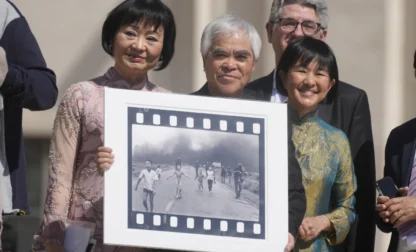By OSKAR GARCIA and RICHARD PYLE
HONOLULU — Edwin Q. White, who served as Saigon bureau chief for The Associated Press as the U.S. committed massive numbers of combat troops to Vietnam, died before dawn Thursday in Honolulu at age 90, his daughter said.
White’s daughter, Rachel White Watanabe, said her father died in his sleep at his home in Honolulu, where he moved after retiring in 1987. Her father was in deteriorating health and had congestive heart failure, she said.
“Ed White led an extraordinary AP bureau that covered the American involvement in Vietnam from its start through the fall of Saigon in 1975,” said John Daniszewski, AP’s senior managing editor for international news. “He embodied accuracy, dispassion and objectivity in his reporting, and his contribution to the telling of that history will never be forgotten by his colleagues.’’
White, known among colleagues as “Quigley,” his middle name, was on emergency duty in Saigon when South Vietnam fell to Hanoi’s communist forces on April 30, 1975. He left on one of the last evacuation helicopters from the roof of the U.S. embassy.
The usually imperturbable journalist _who had planned to eventually retire with his family in Vietnam _ later said the biggest regret of his career was “joining the big bug out from Saigon in ’75, something … I think about almost every day.”
“Going off of the roof of the embassy wasn’t the greatest happening of my life,” he said.
White is one of five former AP Saigon staffers to die this year, including his close friend and former Hawaii neighbor Roy Essoyan, along with George Esper, Horst Faas and Malcolm Browne.
Born in Tipton, Mo., on Aug. 29, 1922, White was a reporter’s reporter _ skeptical, careful, a stickler for accuracy, with an acerbic wit and a no-frills writing style that stressed facts over drama.
In a 1997 oral history interview for AP, White said his love of journalism began in boyhood, when he “got kind of interested” in how Tipton’s weekly paper was printed.
He graduated from the University of Missouri’s prestigious journalism school and saw Army service in WWII. In the Philippines when the war ended in 1945, his unit was sent to Korea to help handle the repatriation of the defeated Japanese troops.
Volunteering for postwar duty in Japan, White joined Pacific Stars and Stripes, a new Asian edition of the military newspaper. “I figured I’d never see Asia again, so I did that,” he said.
Back in civilian life, White spent five years at newspapers in Missouri and Kansas. But he talked of returning abroad, and a boss told him to consider the AP. In 1949, White joined the news service in Kansas City, moved after five years to New York and in 1960 to Tokyo, as news editor in the flagship bureau of AP’s Asian operations.
The growing conflict in Vietnam led international news agencies to expand their staffs, and White soon found himself commuting between Japan and Vietnam, spending weeks at a time in the war zone.
As the U.S. shifted from an advisory to a full combat role in 1965, White was named chief of AP’s Saigon bureau.
In 1979, White left Tokyo for Hawaii. A year later, however, he was dispatched to Seoul, where AP’s all-Korean staff had come under severe government pressure.
He retired in 1987 and returned to Hawaii with his wife, a native of Vietnam, and daughter.
In four decades with AP, Ed White saw his craft evolve from typewriters to computers _ but felt strongly that the digital revolution should not be the doom of traditional journalism.
“If you learn the facts, report them accurately and get people to put it in the newspapers, or television or radio, that’s the mission,” he said in the oral history interview. “The means of doing it may have changed, but not the basic principle.”
White is survived by his wife, Kim, daughter Rachel White Watanabe, and Rachel’s husband, Michael Watanabe.
___
Richard Pyle, who covered Asia for 13 years as a field reporter and bureau chief, contributed to this story from New York. He worked with White during the war.



